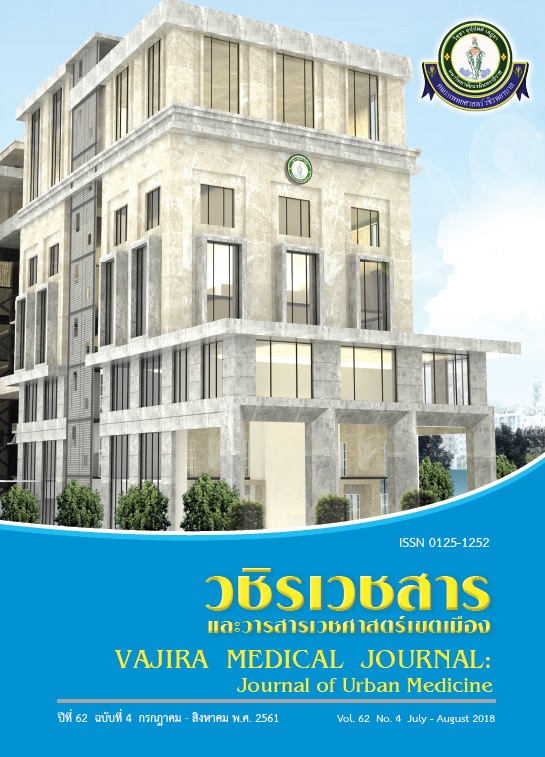Effects of Mother-Infant Skin to Skin Contact on Successful Breastfeeding in Postpartum Mother-Infant Separation: A Randomized Controlled Trial
Main Article Content
Abstract
Objective: To compare successful infant sucking between skin-to-skin contact and non-skin-to-skin contact in postpartum mother–infant separations of 6-24 hours.
Methods: A randomized-controlled trial in 64 mother-infant dyads with normal vaginal delivery and separation of 6-24 hours. Samples were randomized and equally allocated to skin-to-skin contact (SSC) and conventional care (CC). The primary outcome was successful infant sucking rate at the first breastfeed and the second assessment at 6-12 hours later using the Infant Breast-Feeding Assessment Tool (IBFAT). The secondary outcomes were exclusive breastfeeding rate at discharge day, one month and three months postpartum.
Results: Baseline characteristics were similar between groups. The mean IBFAT scores at the first and second breastfeed in the SSC group were significantly higher than the CC group (10.47±1.41 vs. 8.00±1.42 and 11.94±0.25 vs. 10.53±1.11, p < 0.001 respectively). The exclusive breastfeeding rate at discharge was significantly higher in the SSC group (96.9% in SSC group and 65.6% in CC group, p < 0.001), but not significantly different at one and three months postpartum.
Conclusions: postpartum mother-infant separation with SSC significantly enhanced successful infant sucking and the rate of exclusive breastfeeding at discharge.
Downloads
Article Details
References
2. The World Health Organization. Evidence for the ten steps to successful breastfeeding. Geneva: World Health Organization; 1998.
3. The World Health Organization. Protecting, promoting and supporting breast-feeding. Geneva: World Health Organization and UNICEF; 1989.
4. World Health Organization. The optimal duration of exclusive breastfeeding (Results of WHO systemic review). Geneva: World Health Organization; 2001.
5. Aghdas K, Talat K, Sepideh B. Effect of immediate and continuous mother–infant skin-to-skin contact on breastfeeding self-efficacy of primiparous women: a randomized control trial. Women Birth. 2014; 27(1): 37–40.
6. Anderson GC. Kangaroo care of the premature infant. In E. Goldson (Ed.), Nurturing the premature infant: Developmental interventions in the neonatal intensive care nursery. New York: Oxford University Press; 1999. p. 1168–80.
7. Chia P, Sellick K, Gan S. The attitudes and practices of neonatal nurses in the use of kangaroo care. Aust J Adv Nurs. 2006;23(4):20–7.
8. Feldman R. Mother-infant skin-to-skin contact (Kangaroo Care). Theoretical, clinical, and empirical aspects. Infants and Young Children. 2004;17(2):145–61.
9. Feldman R, Eidelman AI, Sirota L, Weller A. Comparison of skin-to-skin (kangaroo) and traditional care: Parenting outcomes and preterm infant development. Pediatrics. 2002; 110(1):16–26.
10. Mercer RT. Becoming a mother versus maternal role attainment. J Nurs Scholarsh. 2004;36(3): 226–32.
11. Moore ER, Anderson GC. Randomized Controlled Trial of Very Early Mother–Infant Skin-to-Skin Contact and Breastfeeding Status. J midwifery women health. 2007;52(2):116-25.
12. Gouchon S, Gregori D, Picotto A, Patrucco G, Nangeroni M, Di Giulio P. Skin-to-Skin Contact After Cesarean Delivery: An Experimental Study. Nurs Res. 2010;59(2):78-84.
13. Mahmood I, Jamal M, Khan N. Effect of Mother- Infant Early Skin-to-Skin Contact on Breastfeeding Status: A Randomized Controlled Trial. J Coll Physicians Surg Pak. 2011;21(10):601-5.
14. Thukral A, Sankar MJ, Agarwal R, Gupta N, Deorari AK, Paul VK. Early Skin-to-Skin Contact and Breast-Feeding Behavior in Term Neonates: A Randomized Controlled Trial. Neonatology. 2012; 102(2):114–9.
15. Svensson K E, Velandia MI, Matthiesen AT, Welles-Nyström BL, Widström AE. Effects of mother-infant skin-to-skin contact on severe latch-on problems in older infants: a randomized trial. Int Breastfeed J. 2013;8(1):1-13.
16. Srivastava S, Gupta A, Bhatnagar A, Dutta S. Effect of Very Early Skin to Skin Contact on Success at Breastfeeding. Indian J Public Health. 2014;58(1): 22 – 6.
17. Thomson ME, Hartsock TG, Larson C. The Importance of Immediate Postnatal Contact Its Effect on Breastfeeding. Can Fam Physician. 1979; 25:1374-8.
18. Marin Gabriel MA, Martin IL, Escobar AL, Villalba EF, Blanco IR, Pol PT. Randomized controlled trial of early skin-to-skin contact: effects on the mother and the newborn. Acta Pedriatr. 2010;99(11):1630-4.
19. Suzuki S. Effect of early skin-to-skin contact on breast-feeding. J Obstet Gynecol. 2013;2(1):15-9.
20. Matthews MK. Developing an instrument to assess infant breastfeeding behavior in the early neonatal period. Midwifery. 1988; 4(4):154-65.
21. Riordan JM, Mary K. Reliability and Validity Testing of Three Breastfeeding Assessment Tools. J Obstet Gynecol & Neonatal Nurs. 1997; 26(2):52-8.
22. Moore ER, Anderson GC, Bergman N, Dowswell T. Early skin-to-skin contact for mothers and their healthy newborn infants. Cochrane Database Syst Rev. 2016;16(5), CD003519.
23. Mizuno K, Mizuno N, Shinohara T, Noda M. Mother-infant skin-to-skin contact after delivery results in early recognition of own mother’s milk odour. Acta Paediatr. 2004;93(12):1640–5.
24. Sosa R, Kennell, JH, Klaus M, Urrutia JJ. The effect of early mother-infant contact on breastfeeding, infectionand growth. In: Elliott K, Fitzsimons DW editor(s). Breastfeeding and the mother: Ciba Foundation Symposium. Vol. 45, New York: Elsevier Excerpta Medica; 1976. p. 179–93.
25. Thomson ME, Hartsock TG, Larson C (1979) The importance of immediate postnatal contact: its effect on breastfeeding. Can fam physician, 25:1374-8.


